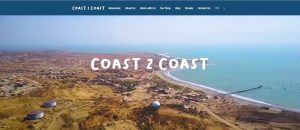Coast 2 Coast
By Emi (equipo@coast2coastmovement.com), co-founder of Coast 2 Coast, Peru; social ecologist; Fulbright Fellow; and National Geographic Explorer based in Lobitos, Northern Peru
From November 2021 to January 2023, throughout the International Year of Artisanal Fisheries and Aquaculture (IYAFA 2022), Coast 2 Coast (C2C), a Peruvian community-based nonprofit, collaborated with rural educators and young learners from public schools, nonprofits, and social welfare centers located in inland and coastal small-scale fishing villages in Peru, Nigeria, Madagascar, and India to co-create the Small-Scale Fisheries Guidelines Curriculum.

The curriculum uses the FAO Voluntary Guidelines for Securing Sustainable Small-Scale Fisheries in the Context of Food Security and Poverty Eradication, or the SSF Guidelines, as a framework for local educators and young learners to explore, envision, and encourage sustainable small-scale fisheries at the local level through an emergent strategy.
The curriculum is an inspired outcome of the 2022 publication by Dr. John Kurien, “Involving the People – Democratizing the Implementation and Monitoring of the Voluntary Guidelines for Securing Sustainable Small-Scale Fisheries in the Context of Food Security and Poverty Eradication.” The report highlights the need for democratizing the implementation and monitoring of the SSF Guidelines at the community level through contextualized participatory assessment tools and mechanisms.
The curriculum serves as a medium for raising awareness about the SSF Guidelines through young people’s exploration of its themes as reflected in their daily lives growing up in fish-dependent villages. The learning framework contains dynamic youth action and community-based participatory approaches that enable educators to guide their students and learners in monitoring and evaluating the implementation of the SSF Guidelines in their communities, sharing their results as part of Too Big To Ignore’s “20 Questions about Small-Scale Fisheries,” and inviting educators to create profiles of the SSF communities upon the curriculum’s completion.
Applying the essential findings and processes described in the ‘Involving the People’ report, the SSF Guidelines Curriculum transdisciplinary development team reviewed each paragraph of the guidelines’ 13 chapters, highlighting the key takeaways and uncovering the overarching “story” each guideline tells about small-scale fisheries. In parallel, C2C met remotely with educators working in diverse small-scale fishing villages and initiated the co-design process through in-depth interviews.
Educators generously offered their time and participation, sharing the specific challenges facing their SSF and the opportunities they foresaw. C2C inquired about the teaching and learning methods educators thought worked best for their local context and any innovative or alternative teaching methods they would be interested in developing new skills, for example, using audiovisual tools in teaching and learning processes. Educators discussed their personal goals as community members and professional goals as teachers, facilitators, and social workers. In addition, C2C learned about the local fishing practices, cultural values, and traditional knowledge that would inform the curriculum’s design.
Together, C2C and educators co-designed a lively collection of lesson plans and enrichment activities that sought to meet the needs of SSF educators and make learning meaningful and relevant for participants through their own investigations and imaginations.
For more information: https://www.coast2coastmovement.com/